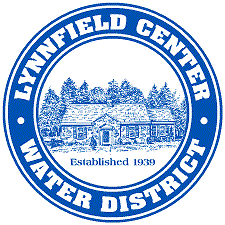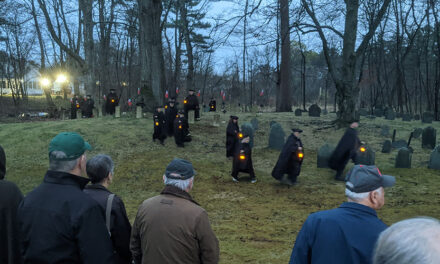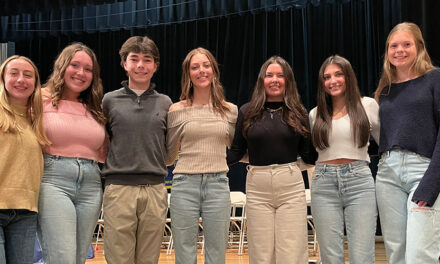Published December 23, 2020

By DAN TOMASELLO
LYNNFIELD — Upgrading the Lynnfield Center Water District’s system will cost just under $10 million.
After two years of study, LCWD Superintendent John Scenna said during a Dec. 14 informational meeting on Zoom teleconference that consultant CDM Smith is recommending between $9 million and $9.5 million in capital improvements in order to address the district’s water quality and quantity issues. The projects involve upgrading the LCWD’s existing infrastructure as well as getting supplemental water from the Massachusetts Water Resource Authority (MWRA) via Wakefield.
“These projects will diversify our water sources,” said Scenna. “It is going to ease restrictions, will allow for future growth and will provide consistency in the water.”
In order to address the discolored water problems ratepayers living near the North Reading line have experienced, CDM Smith project engineer/manager Mike Nelson recommended that ratepayers approve building a $6 million greensand filter treatment plant at the Glen Drive station in order to treat iron and manganese. The project also includes making improvements to the district’s Main Street station.
“I can sit here and say this will work because there has been a water treatment plant at Phillips Road for the better part of two decades,” said Nelson. “The water that comes out of Phillips Road and fills the Knoll Road tank is clear. It does not have the same problems that the water at Glen Drive has. It is proven technology.”
Nelson said CDM Smith also recommends that the LCWD receive supplemental water from the MWRA via Wakefield, which will cost between $1.2 million and $1.5 million. He said the cost to join the MWRA is $1.6 million, which could be spread out over 20 years. He also said the MWRA’s permitting costs range between $250,000 and $350,000.
The supplemental water project involves connecting the two systems at Main Street and Bay State Road.
“This is an ideal spot to put an interconnected vault,” said Nelson. “Wakefield has no issues with that vault being underground and we can drop electrical service right off a pole. It is a favorable spot. We also did some modeling, and found that the hydraulics is favorable. In order to pull 25 percent of the district’s demand through Wakefield did not require any pumping. We may have to upsize some mains in the district, but not having to pump that water is a huge cost savings.”
Nelson said the project would benefit Wakefield as well as the LCWD.
“Wakefield has a fire flow distribution issue,” said Nelson. “The solution is to create a loop for Wakefield through Lynnfield that would allow them to loop their system. It would alleviate a large problem for them.”
Scenna said getting supplemental water from the MWRA will benefit the LCWD over the long-term.
“It will help regulate pressure throughout the system and will help maintain fire suppression throughout the system,” said Scenna. “It will also reduce restrictions in the summer.”
Nelson said the LCWD also explored the possibility of getting supplemental water from the MWRA via the Lynnfield Water District (LWD). He said this project was eliminated because it would be incredibly expensive.
“The issues that we faced with the Lynnfield Water District is that their system was never designed to convey water through their system to the Lynnfield Center Water District,” said Nelson. “There are pipelines that would need to be upgraded. One of the biggest issues is the main pumping system, which is the brick building on Route 1 that is across the Christmas Tree Shops. In order to move enough water through Lynnfield Water District into LCWD, that pumping station would need a major upgrade. The Lynnfield Water District also had very specific requirements for the infrastructure that would have to be built as part of this project. They were requiring that any interconnection of the two systems would have to take place in an above ground architectural structure and not buried underground in the roadway. That would require a land acquisition, so the district would have to go out and buy land or agree to a long-term lease agreement, and then construct a building. Between that, the significant improvements to the main pumping station and the pipelines that would need to be upgraded, it became quite expensive.”
Nelson said LCWD also explored getting supplemental water from Peabody as well as Andover via North Reading. He noted that Peabody rejected the proposal right out of the gate. Nelson said CDM Smith recommended against pursuing connections with Andover via North Reading due to the expensive infrastructure upgrades that would be needed in order to get supplemental water from Haggetts Pond and the Merrimack River.
Scenna noted that the Wakefield plan costs $1 million less than the other three proposals. He said getting all of the LCWD’s water from the MWRA is too expensive and doing nothing is not feasible.
“We have to move forward,” said Scenna. “We can’t do nothing, but at the same time, it’s not fiscally responsible to shut everything down and go to the MWRA.”
In addition to the greensand filter treatment plant and supplemental water projects, Nelson said CDM Smith is also recommending that station one at the Phillips Road facility be brought back on line so it can be used during the summer. He recalled that station one was used last summer on an emergency basis when the LCWD had to implement Level 5 restrictions.
“We are going to get another 50 gallons a minute out of it,” said Nelson. “There is no capital cost with it. The district will be able to accomplish this in its operating budget.”
Scenna said the Board of Water Commissioners will be discussing the project’s financial impact on ratepayers during a January meeting.
In response to a question from Patrice Lane resident Pat Campbell, Scenna said the MWRA water would be blended with LCWD’s groundwater throughout the year.
“It would be part of how we operate the system,” said Scenna.
Water Commissioners Chairman Joe Maney encouraged ratepayers to closely follow the project over the next several months. Ratepayers will tentatively be asked to approve the project during the Annual Meeting in April.
“We need you people involved,” said Maney. “You are going to decide the direction of this district. The superintendent and the three commissioners are not. We need the public to be involved in order to move anything forward.”
If ratepayers have any questions about the project, Scenna said they can send an email to lcwd@lcwd.us or can call the district at 781-334-3901.




